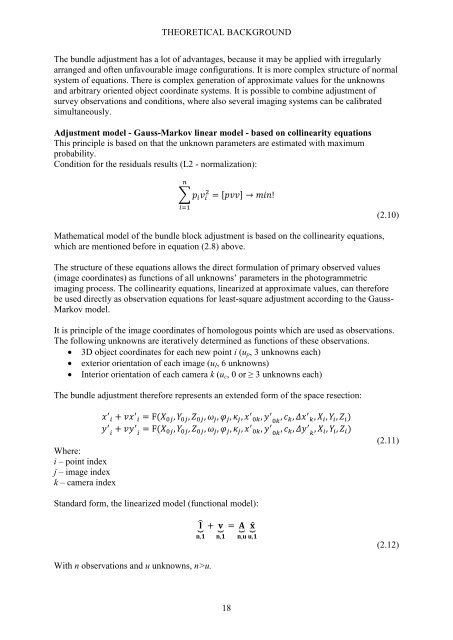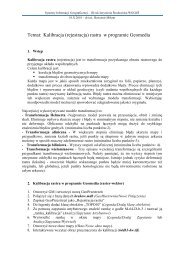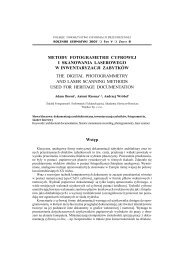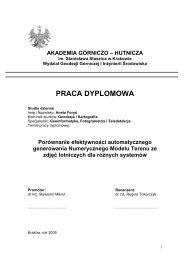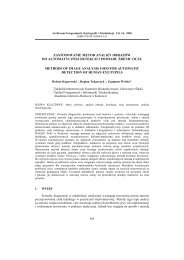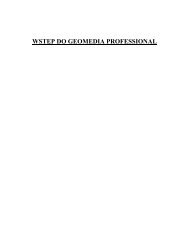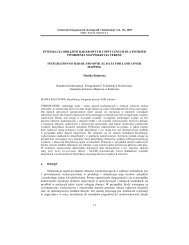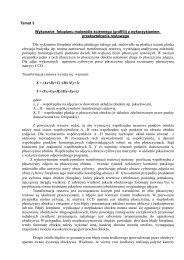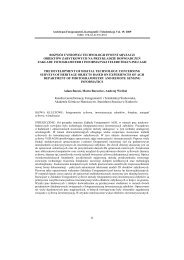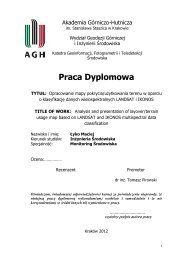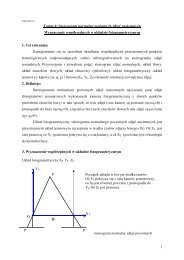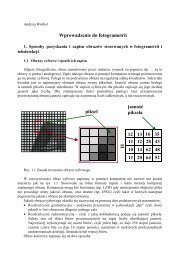Praca Dyplomowa - Photogrammetry and Remote Sensing - AGH
Praca Dyplomowa - Photogrammetry and Remote Sensing - AGH
Praca Dyplomowa - Photogrammetry and Remote Sensing - AGH
Create successful ePaper yourself
Turn your PDF publications into a flip-book with our unique Google optimized e-Paper software.
THEORETICAL BACKGROUND<br />
The bundle adjustment has a lot of advantages, because it may be applied with irregularly<br />
arranged <strong>and</strong> often unfavourable image configurations. It is more complex structure of normal<br />
system of equations. There is complex generation of approximate values for the unknowns<br />
<strong>and</strong> arbitrary oriented object coordinate systems. It is possible to combine adjustment of<br />
survey observations <strong>and</strong> conditions, where also several imaging systems can be calibrated<br />
simultaneously.<br />
Adjustment model - Gauss-Markov linear model - based on collinearity equations<br />
This principle is based on that the unknown parameters are estimated with maximum<br />
probability.<br />
Condition for the residuals results (L2 - normalization):<br />
∑ [ ]<br />
Mathematical model of the bundle block adjustment is based on the collinearity equations,<br />
which are mentioned before in equation (2.8) above.<br />
18<br />
(2.10)<br />
The structure of these equations allows the direct formulation of primary observed values<br />
(image coordinates) as functions of all unknowns‟ parameters in the photogrammetric<br />
imaging process. The collinearity equations, linearized at approximate values, can therefore<br />
be used directly as observation equations for least-square adjustment according to the Gauss-<br />
Markov model.<br />
It is principle of the image coordinates of homologous points which are used as observations.<br />
The following unknowns are iteratively determined as functions of these observations.<br />
� 3D object coordinates for each new point i (up, 3 unknowns each)<br />
� exterior orientation of each image (uI, 6 unknowns)<br />
� Interior orientation of each camera k (uc, 0 or ≥ 3 unknowns each)<br />
The bundle adjustment therefore represents an extended form of the space resection:<br />
Where:<br />
i – point index<br />
j – image index<br />
k – camera index<br />
(<br />
(<br />
St<strong>and</strong>ard form, the linearized model (functional model):<br />
With n observations <strong>and</strong> u unknowns, n>u.<br />
⏟̂<br />
⏟<br />
⏟<br />
̂⏟<br />
)<br />
)<br />
(2.11)<br />
(2.12)


